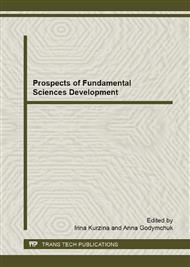[1]
W.D. Brewer, R.K. Bird, T.A. Wallace, Titanium Alloys and Processing for High Speed Aircraft, Mater. Sci. Eng., A. 243, 1–2 (1998) 299-304.
DOI: 10.1016/s0921-5093(97)00818-6
Google Scholar
[2]
Yu.S. Nechaev, Metallic Materials for Hydrogen Energy Industry and Main Gas Pipelines: Complex Physical Problems of Aging, Embrittlement and Failure, Uspekhi Fizicheskikh Nauk (in Russian). 178, 7 (2008) 709-726.
DOI: 10.1070/pu2008v051n07abeh006570
Google Scholar
[3]
V.N. Kudiiarov, A.M. Lider, N.S. Pushilina, Hydrogen redistribution in technically pure titanium alloy under X-ray exposure at room temperature, Adv. Mater. Res. 880 (2014) 74-79.
DOI: 10.4028/www.scientific.net/amr.880.74
Google Scholar
[4]
F.P. Korshunov, Radiation Technology, Nauka naronomy chosiaystvy, 1 (2000) 236-254.
Google Scholar
[5]
М. N. Мiheev, Magnetic Methods of Structural Analysis and Non-destructive Testing, Institut fiziki metallov, Nauka, Moscow, (1993).
Google Scholar
[6]
V.V. Larionov, Shi Kun , Xu Shupeng, Study of the Internal Structure of Hydrogenated Metals of Different Frequency Eddy Current Method, Vedecky Prumysl Evropskeho Kontinentu 2013: Materially VIII Mezinarodni Vedecko-Prakticka Konference. Praha: Education and Science, Matematika. 23 (2013).
Google Scholar
[7]
R.A. Sacs, J.E. Robinson, Electrical Resistivity of Dislocation Arrays, Phys. Rev. B: 13, 2 (1976) 611-620.
Google Scholar
[8]
N.A. Timchenko, R.M. Galimov, А.М. Lider, B.G. Goldenberg, A.N. Shmakov, Phases in Decay Hydrogenated Palladium and Titanium Irradiated Synchrotron Radiation Beam X-ray Region, Bulletin of the Russian Academy of Sciences: Physics (in Russian). 77, 2 (2013).
DOI: 10.3103/s1062873813020366
Google Scholar
[9]
A.S. Karolik, Electrical Resistivity and Thermopower in Compact Sub-boundaries Submicrostructure. Cooper. Мaterialovedenie (in Russian). 4 (2011) 15-19.
Google Scholar
[10]
P.V. Geld, R.A. Ryabov, E.S. Kodes, Hydrogen and Defects of the Metal Structure, Metallurgiya, Moscow (in Russian), (1979).
Google Scholar
[11]
V.N. Kudiiarov, L.V. Gulidova, N.S. Pushilina, A.M. Lider, Application of automated complex Gas Reaction Controller for hydrogen storage materials investigation, Adv. Mater. Res. 740 (2013) 690-693.
DOI: 10.4028/www.scientific.net/amr.740.690
Google Scholar
[12]
A.M. Lider, N.S. Pushilina, V.N. Kudiiarov, Investigation of hydrogen distribution from the surface to the depth in technically pure titanium alloy with the help of Glow Discharge Optical Emission Spectroscopy, Adv. Mech. Mater. 302 (2013) 92-96.
DOI: 10.4028/www.scientific.net/amm.302.92
Google Scholar
[13]
A.V. Panin, M.S. Kazachenok, O.M. Borodovitsina, O.V. Perevalova, Y.F. Ivanov, A.M. Lider, O.M. Stepanova, M.H. Kroening, The Effect of Electron Beam Treatment on Hydrogen Sorption Ability of Commercially Pure Titanium, App. Surf. Sci. 284 (2013).
DOI: 10.1016/j.apsusc.2013.07.166
Google Scholar
[14]
Yu. I. Tyurin, N.N. Nikitenkov, V.V. Larionov, Ionizing Radiation– Stimulated Diffusion and Desorption of Hydrogen from Metals, Russian J. of Phys. Chem. А, 85, 6 (2011) 1047-1053.
DOI: 10.1134/s0036024411060318
Google Scholar
[15]
Y.S. Bordulev, R.S. Laptev, V.N. Kudiiarov, A.M. Lider, Investigation of commercially pure titanium structure during accumulation and release of hydrogen by means of positron lifetime and electrical resistivity measurements, Adv. Mater. Res. 880 (2014).
DOI: 10.4028/www.scientific.net/amr.880.93
Google Scholar
[16]
V.N. Kudiiarov, A.M. Lider, S.Y. Harchenko, Hydrogen accumulation in technically pure titanium alloy at saturation from gas atmosphere, Adv. Mater. Res. 880 (2014) 68-73.
DOI: 10.4028/www.scientific.net/amr.880.68
Google Scholar
[17]
R.S. Laptev, Y.S. Bordulev, V.N. Kudiiarov, A.M. Lider, G.V. Garanin, Positron annihilation spectroscopy of defects in commercially pure titanium saturated with hydrogen, Adv. Mater. Res. 880 (2014) 134-140.
DOI: 10.4028/www.scientific.net/amr.880.134
Google Scholar


